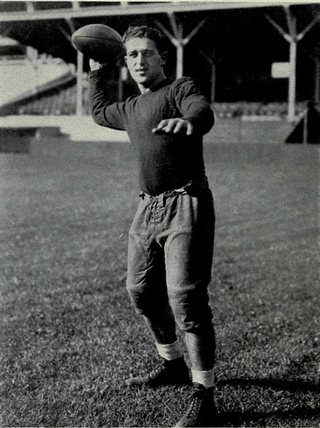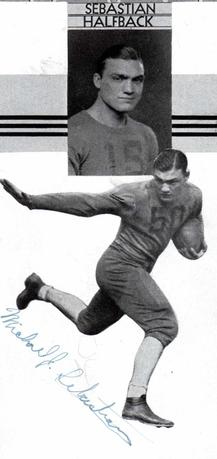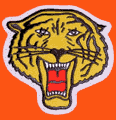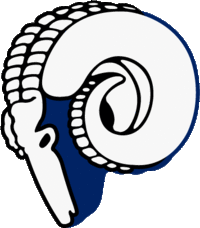Related Research Articles

The All-America Football Conference (AAFC) was a major professional American football league that challenged the established National Football League (NFL) from 1946 to 1949. One of the NFL's most formidable challengers, the AAFC attracted many of the nation's best players, and introduced many lasting innovations to the game. However, the AAFC was ultimately unable to sustain itself in competition with the NFL. After it folded, three of its teams were admitted to the NFL: the San Francisco 49ers, the Cleveland Browns and the original Baltimore Colts.
Below is a list of professional football Championship Games in the United States, involving:
The 1990 NFL season was the 71st regular season of the National Football League (NFL). To increase revenue, the league, for the first time since 1966, reinstated bye weeks, so that all NFL teams would play their 16-game schedule over a 17-week period. Furthermore, the playoff format was expanded from 10 teams to 12 teams by adding another wild card from each conference, thus adding two more contests to the postseason schedule; this format was modified with realignment in 2002 before the playoffs expanded to 14 teams in 2020.
Throughout the years, a number of teams in the National Football League (NFL) have either moved or merged.
The first American Football League (AFL), sometimes called AFL I, AFLG, or the Grange League, was a professional American football league that operated in 1926. It was the first major competitor to the National Football League (NFL). Founded by Charles "C.C." Pyle, (1882–1939), and General Charles X. Zimmerman, (1865–1926), as vice president and starring Hall of Fame halfback Harold Edward "Red" Grange, (1903–1991), the short-lived league with nine teams competed against the more established – then six-year-old – NFL, both for players and for fans. While Pyle's and Grange's New York Yankees team and the already established Philadelphia Quakers became reliable draws, the lack of star power and the uncertain financial conditions of the other seven teams led to the league's dissolution after one season.

Harry Lawrence Newman was an American professional football player who was a quarterback in the National Football League (NFL) and American Football League. He played college football for the Michigan Wolverines (1930–32), for whom in 1932 he was a unanimous first-team All-American, and the recipient of the Douglas Fairbanks Trophy as Outstanding College Player of the Year, and the Helms Athletic Foundation Player of the Year Award, he was later inducted into the College Football Hall of Fame. He then played professionally for the New York Giants (1933–35), earning All-Pro honors, before joining the Brooklyn/Rochester Tigers (1936–37).

Michael John "Lefty" Sebastian was an American football halfback in the National Football League (NFL) for the Cincinnati Reds, Boston Redskins, Philadelphia Eagles, Pittsburgh Pirates, and the Cleveland Rams. Nicknamed the Rose of Sharon, he also played for the Rams while they were still members of the second American Football League (AFL) as well as the AFL's Rochester Tigers. Prior to his professional career, Sebastian played college football at the University of Pittsburgh. At Pitt, he played under coach Jock Sutherland, who had declared Sebastian the best passer whom he had seen in "many days."
The American Football League, also known retrospectively as the AFL III to distinguish it from earlier organizations of that name, was a professional American football league that operated from 1940 to 1941. It was created when three teams, the original Cincinnati Bengals, the Columbus Bullies, and the Milwaukee Chiefs, were lured away from the minor-league American Professional Football Association and joined three new franchises in Boston, Buffalo, and New York City in a new league. It competed against the National Football League (NFL), the oldest existing professional football league, which had been established in 1920 and reorganized in 1922.
The American Football League (AFL) was a professional American football league that operated in 1936 and 1937. The AFL operated in direct competition with the more established National Football League (NFL) throughout its existence. While the American media generally ignored its operation, this second AFL was the first "home" of the Cleveland Rams, which joined the National Football League after one year in the AFL.
The Midwest Football League (MFL) was a professional American football minor league that existed from 1935 to 1940. Originally comprising teams from Ohio, Kentucky, Indiana, and Illinois, the league eventually expanded its reach to include teams from Missouri, Tennessee, Wisconsin, and California to become a national league with major league aspirations by 1939. In 1938, the league became the American Professional Football League after the collapse of the second major league of the same name, but changed its name once again the following year to American Professional Football Association (APFA). Some sources refer to it as the American Professional Football League.
The 1936 AFL season is the first season of the second American Football League, the formation of which was announced by Harry March, former personnel director of the NFL's New York Giants, on December 15, 1935. Fifteen cities bid for charter franchises; on April 11, 1936, franchises were awarded to eight cities: Boston, Cleveland, Jersey City, New York, Philadelphia, Pittsburgh, Providence, and Syracuse. By mid-summer, Jersey City, Philadelphia, and Providence withdrew; soon afterwards, Rochester was given a franchise, only to have it relocated to Brooklyn, despite the lack of availability of a home stadium at the time.
The Pacific Coast Professional Football League (PCPFL), also known as the Pacific Coast Football League (PCFL) and Pacific Coast League (PCL) was a professional American football minor league based in California. It operated from 1940 through 1948. One of the few minor American professional sports leagues that competed in the years of World War II, the PCPFL was regarded as a minor league of the highest level, particularly from 1940 to 1945, at a time in which the National Football League (NFL) did not extend further west than Chicago and Green Bay. It was also the first professional football league to have a team based in Hawaii.

The Los Angeles Bulldogs were a professional American football team that competed from 1936 to 1948. Formed with the intention of joining the National Football League in 1937, the Bulldogs were the first team on the major league level to play its home games on the American West Coast. They were considered "the best football team in existence outside the NFL".

The Rochester Tigers were a professional American football team that competed in the second American Football League in 1936 and 1937. Owned by Mike Palm and Harry Newman, the Tigers were originally awarded to Rochester as a charter member of the AFL, but were shifted to Brooklyn two weeks afterward despite the lack of availability of a home stadium in its new home town, then moved back to Rochester midway through the 1936 season.
The Pittsburgh Americans or Pittsburgh Amerks were a professional American football team based in Pittsburgh, Pennsylvania from 1936 until 1937. The team was a member of the major-league American Football League and participated in the league's 1936 and 1937 seasons.
The New York Yankees of the second American Football League was the second professional American football team competing under that name. It is unrelated to the Yankees of the first AFL, the Yankees of the third AFL, the Yankees of the American Association and the (later) Yankees of the All-America Football Conference. The Yankees played their home games in Yankee Stadium and Triborough Stadium in New York, New York. Jack McBride was the team’s head coach throughout its existence; Yankees' president James Bush served as president of the second American Football League in 1936.
This timeline of the National Football League (NFL) tracks the history of each of the league's 32 current franchises from the early days of the league, through its merger with the American Football League (AFL). The history of franchises that began as independent teams, or as members of the Ohio League, New York Pro Football League, and other defunct leagues are shown as well.

The Cleveland Rams were a professional American football team that played in Cleveland from 1936 to 1945. The Rams competed in the second American Football League (AFL) for the 1936 season and the National Football League (NFL) from 1937 to 1945, winning the NFL championship in 1945, before moving to Los Angeles in 1946 to become the first of only two professional football champions to play the following season in another city.
References
- 1 2 History of Football in Western New York Archived September 19, 2011, at the Wayback Machine
- 1 2 3 George Gipe, The Great American Sport Book (Doubleday 1978) ISBN 0-385-13091-0
- 1 2 Bob Carroll, Michael Gershman, David Neft, and John Thorn, Total Football II: The Official Encyclopedia of the National Football League (HarperCollins 1999) ISBN 0-06-039232-0
- ↑ Pay Dirt: The Business of Professional Team Sports
- ↑ Biography of Hal Pennington- Xavier University Hall of Fame